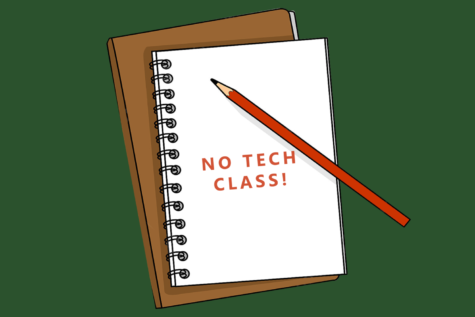OPINION | Tech in classrooms has consequences
February 15, 2023

Technology is an integral part of modern learning. Technology use in school is widespread — students email professors, submit assignments, take assessments, read, take notes and research all on one device. There are downsides to using technology in learning, though, as it can distract students and reduce engagement in the classroom.
So, how do students and professors balance the harm and benefits of technology in class? The inputs of 13 different Tulane University students and a deep dive with Peter C. Kunze, professor of communication at Tulane, help explain this predicament.
A survey asked 13 students about their opinions on technology use in class. Around 45% of students surveyed said they only use technological devices to take notes in class. In comparison, 36% of the students indicated that they use a mix of handwritten and electronic notes. Overall, 81% of surveyed students used personal devices in class in some capacity.
Students who take notes on computers indicated that they take more organized and efficient notes this way. However, 76.9% of the students suggested that technology in classrooms could be distracting.
A handful of students mentioned getting distracted by what their peers do on their devices. Students also noted that using their own devices can be a distraction.
Students offered solutions for hindering distraction. For example, one student mentioned that they try to sit in the front to avoid viewing other screens. Other students mentioned ways that they limit distractions on their devices, such as downloading work and disconnecting from the internet.
Research conducted by a group of psychologists at Butler University in 2020 aligns with the idea that students feel distracted by their peers’ screens. The study concluded that students are likely to be negatively impacted by what their classroom “neighbors” are doing on their devices if it is considered “off-task.”
In an interview with Kunze, he discussed how he addresses the use of technology in his classroom and how he believes students can get the most out of their learning by using electronic devices. Kunze stated that he does not enforce a no-tech policy in his classroom. One of his main arguments against this policy concerns accessibility — “certain students have a right to have those things,” he said.
However, Kunze tries to foster an engaged learning environment by addressing off-task students. He said, “the first time is a gentle reminder, … if it persists, there’s the risk that they’ll disrupt and distract those around them. So then I’m proud to ask them to leave at that time.” This exemplifies some of the ways professors adapt to technology in classroom settings and address potential distractions.
Kunze advises other professors on what they can do to help students learn best through technology. He said, “I think being kind of aware of those range of competencies and where students are at and getting them to a better place … is a challenge that we all face, but doing so with care and compassion is perhaps the best way to tackle it.”
Technology has become a part of our learning experience as college students. Canvas, for example, is important for Tulane students to access. Most professors have adapted to the platform to post assignments, readings, tests, quizzes, etc. Technology is the path higher education institutions like Tulane are taking, and it is an adaptive process.
As older members of Generation Z, current Tulane students undoubtedly grew up in a unique time period. Around 2009, students had access to computers in classrooms, and perhaps students even recall a time when using computers was seen as a privilege or reward. But the extent to which these devices are used has drastically increased in the past decade.
Most Tulane undergraduates grew up during the transition from limited computer access in the home to its inescapable presence today. Undoubtedly, students learned to adapt to personal devices in the academic sphere. Being distracted by the many uses of technology is a natural part of this change.
To best address technology use in the classroom, students must find their own ways to alleviate digital distraction and remain engaged. Professors should remember that students learn in unique ways and should cater to these different learning styles. Overall, technology in education is here to stay, and this generation occupies a unique buffer zone, witnessing both traditional and modern classroom settings.








Leave a Comment